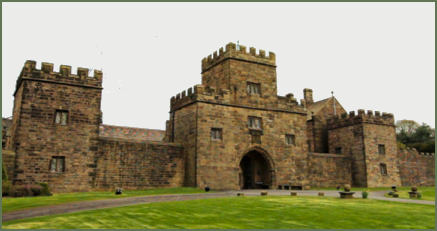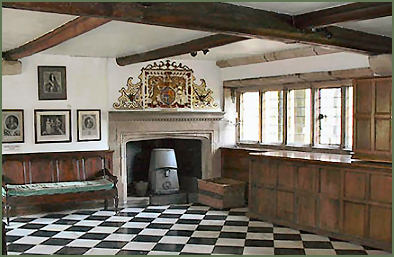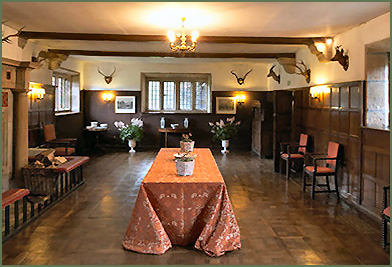Hoghton Tower
OS Grid ref:- SD623264
 The fortified manor house of Hoghton Tower stands on a hilltop to the east of the village of Hoghton in Lancashire.
The fortified manor house of Hoghton Tower stands on a hilltop to the east of the village of Hoghton in Lancashire.
The house occupies a commanding position, 650 feet above sea level mid-way between Preston and Blackburn, with magnificent views of Lancashire, the Lake District and North Wales.
Hoghton Tower is the ancestral home of the de Hoghton family, who have owned the estate since at least the twelfth century. The family descend from Harvey de Walter, a contemporary of William the Conqueror and through the female line from Lady Godiva of Coventry, wife of Leofric, Earl of Mercia. The family name of de Hoghton was adopted in 1150.
The present house was built for Thomas de Hoghton in around 1560–65 and replaced an earlier house which occupied the site. One of the first visitors was the young playwright, William Shakespeare. He stayed with the family as a member of a troup of theatrical players and whilst there he was a tutor to the children.
 A Roman Catholic, Thomas de Hoghton lived in the house for only four years before fleeing to the Low Countries, where he died. His Protestant nephew and successor, Richard, the first baronet, earned the favour of the first Stuart king, James I, who was a visitor to Hoghton Tower in 1617. At a banquet held at Hoghton Tower in his honour, he famously knighted a joint of beef ‘Sir Loin’.
A Roman Catholic, Thomas de Hoghton lived in the house for only four years before fleeing to the Low Countries, where he died. His Protestant nephew and successor, Richard, the first baronet, earned the favour of the first Stuart king, James I, who was a visitor to Hoghton Tower in 1617. At a banquet held at Hoghton Tower in his honour, he famously knighted a joint of beef ‘Sir Loin’.
Gilbert de Hoghton, Richard's son, chose to support the Royalist cause at the outbreak of the Civil War and in 1643 Hoghton Tower was damaged by Parliamentary forces but was later repaired by Sir Charles de Hoghton between 1692 and 1702.
The Hoghton family ceased to live in the house from 1768, and although rented out for a while. By the mid nineteenth century it had deteriorated into a sad state of repair. The Victorian author Charles Dickens visited in 1854 and found it in a depressing state. The atmosphere of the derelict tower inspired Dickens to write a story "George Silverman's Explanation", a short story serialised in the American journal, the Atlantic Monthly, in which the house features prominently.
 Sir Henry de Hoghton, the 9th Baronet, who inherited the estate in 1862, set about restoring the building, he engaged the services of the Lancaster architects Paley and Austin. Sir Henry died in 1876, but restoration work was continued by his brother and successor, Charles de Hoghton, the 10th Baronet.
Sir Henry de Hoghton, the 9th Baronet, who inherited the estate in 1862, set about restoring the building, he engaged the services of the Lancaster architects Paley and Austin. Sir Henry died in 1876, but restoration work was continued by his brother and successor, Charles de Hoghton, the 10th Baronet.
The sandstone building has a double courtyard plan, the outer courtyard is entered through a large castellated gatehouse.The house is approached by a long straight drive from the A675 road. The State Bedroom boasts a carved State Bed, the beautifully proportioned Ball Room has decorative late Victorian doors and panelling by Gillows of Lancaster. The magnificent Banqueting Hall with windows containing 4,000 panes of Flemish stained glass, original decorative ceiling and Minstrels’ Gallery. Leading off the Minstrels’ Gallery is the room containing an impressive collection of Dolls’ Houses.
The open piece of land in front of the house is known as the Tilting Green, a space used in medieval times for jousting. On the east side lies a walled garden, known as the Wilderness, while the south side has smaller walled gardens, the Rose Garden and the Rampart Garden. The Great Barn, dated 1692, incorporates a cart house.
Gift shop and tearoom.
